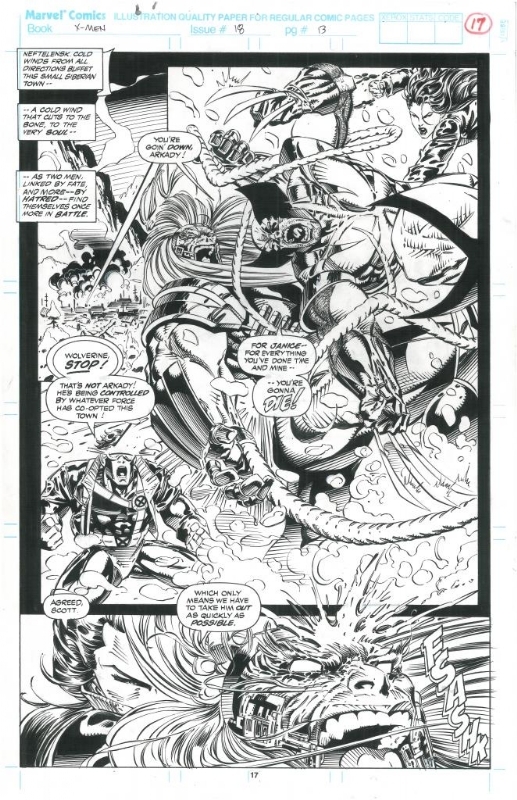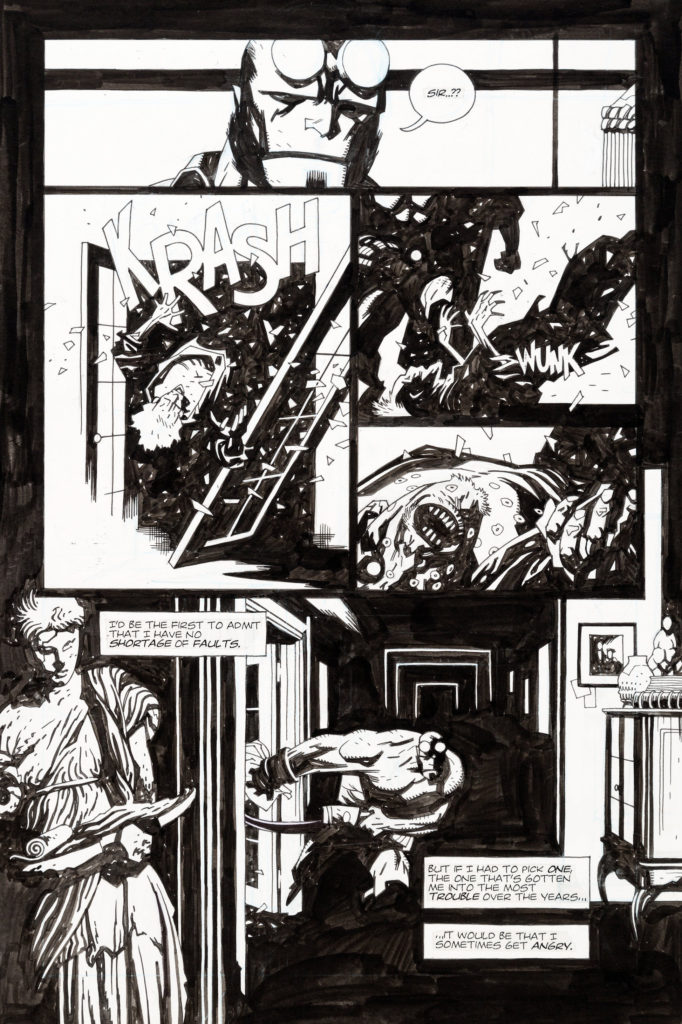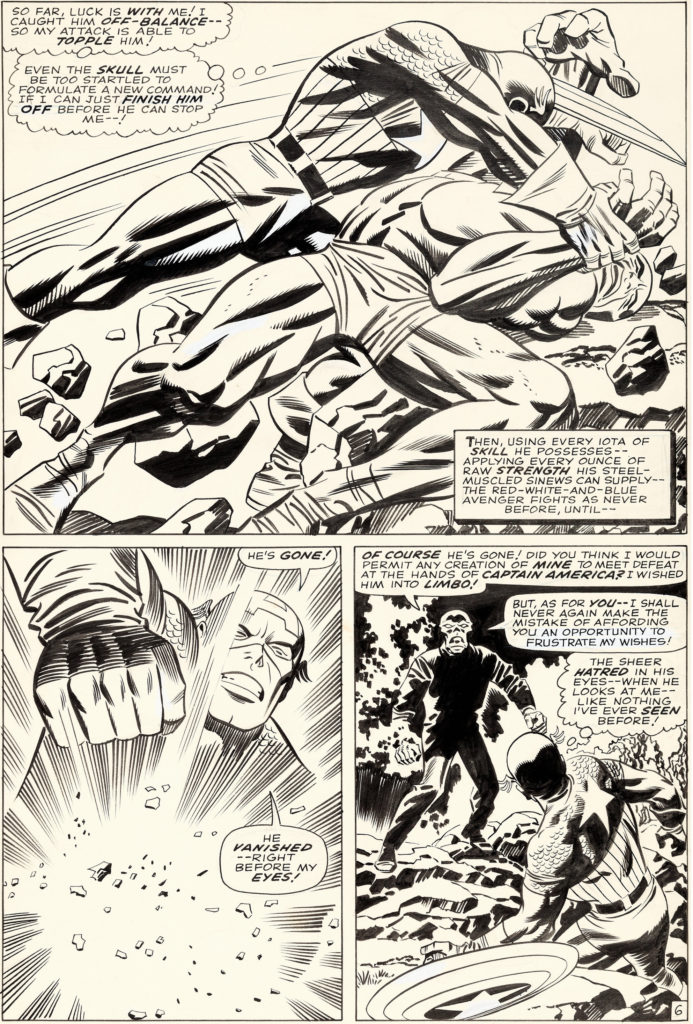
grading comic art
So now that we have a formula to determine the desirability of a piece of art, the next step we will take is to grade it.
In The ABC’s of comic art we looked at art on a macro level(Who drew what and what is its significance in comicdom), where in this section we will be looking at art on a micro level (What is the content and quality related to other pieces from the same body of work.)
The ability to impartially and accurately grade a piece is probably one of the most important abilities to develop in this hobby. A lot of this becomes instinctual with enough experience. It is extremely common for new collectors and it is relatively common for experienced collectors to have a hard time discerning the differences between a good and great piece(or even mediocre to good art.) This becomes important when deciding what you are willing to pay for a piece, as well as adding or subtracting to the quality of your overall collection. In the truly great collections, pieces have that “it” factor. Many collections however may have all of the right Artists, Backgrounds and Characters, but none of the right “art.” A collection of mediocre pieces is in general going to be a mediocre collection, no matter what the focus(mediocre doesnt equal cheap either, their are amazing collections of inexpensive art out there.) In this article we will try to define the characteristics that truly create the wow factor, as well as a simple scale for grading art. Value of art rises parabolically with regard to quality/desirability, so collectors can end up making huge mistakes when purchasing or selling art if they don’t have their eye for art trained yet.
To create an easy to remember system, we will use 5W1H system. The first four refer to content of the page where:
Who
Who are the characters on the page? A page with Batman and Joker is going to be more desirable than a page with Batman and a random thug.
What
What are the characters doing? A page with Batman fighting is going to be a higher grade than Batman sitting in a chair.
Where
Where does the scene take place? A scene with Batman on the rooftops of Gotham is usually going to be a better page than one with him in an office. Pages lacking in background can often hurt the grade.
Why
Why
Why is the scene taking place, what is the dialogue? How does it further the story? Batman figuring out the Joker’s secret plan is going to be better than a page with Batman telling Robin he needs to do his laundry.
The when and the how can be used to examine the “quality” of the work.
When
Peak period of art this was mentioned briefly in the ABC’S of comic art as part of the background of a piece. This is also one part of the grade of a piece. All artists have their strong periods, their average periods, and their weak periods. Peak output art is much more desirable than weak output art, even if the character and content is the same.
How
Sometimes mistakes in actual rendering, which happen quite often, can change the desirability of a piece. Likewise above average rendering can enhance a piece. Ironically, if the artist always make the same “mistakes” in rendering, it simply becomes a style. Sometimes however artists make actual mistakes, they they either don’t have the time or care to fix, or don’t realize until it is too late and the work has been published.
Going though these questions quickly can help you more accurately weigh a piece with you brain when your heart is screaming “Awesome! I must have this.”.

A few more factors in page grading;
X-Factors
When characters are performing their “signature” actions, desirability of pages goes up quickly. For instance, a page with Wolverine claws out in berserker mode is usually going to grade higher than a page with claws retracted. A page with Captain America throwing his shield is going to grade higher than one with him sitting on it. A page with a hero fighting his arch nemesis is usually going to grade high. These signature pages are the ones all collectors really want and often times are the pages with the real “it” factor.
Inkers Matter
One thing new collectors will often do is completely ignore inkers and just pay attention to pencillers. As you develop you eye you will start to recognize some inkers do great with some pencillers, some not so much. pay attention, as the grade of a piece could swing significantly do to poor(or excellent) inks.
Look through material first (scale)
Some artists produce few A level pages. Some artists produce no A+ level pages. Some artists produce lots of them. It is important to actually look at an artists body of work to get a sense of the scope of their art. Many artists may produce less than 20 covers or splashes for a project, and only a few hundred panel pages. It is very useful to rate them in your head at minimum, if not on paper so you know where specific pieces rate on the scale of the artists body of work. If you know a project is very low on top shelf pieces, you might actually have to scale grades up a bit to get a sense of how good a page is in the overall scheme of things.
Impact
When grading art is important to assess how a piece presents in person compared to in picture/scan. Remember earlier we talked about how size is much more significant in person than in scans. This applies to rendering of the art as well. I am always amazed how different art can look in person compared to scans. You will get a strong idea of how a certain artist presents in person after you see a few of their pieces in hand. There are many artists whose work MUST be seen in person to be truly appreciated. On the flip side there are pieces which can be downright disappointing in hand. I have gotten pieces that I immediately regretted purchasing after holding the piece in hand. On the flip side I have gotten pieces I thought looked okay, only to be blown away in person, the art begging to be hanged and displayed.
Checking Boxes Syndrome
A common error many make in this hobby, this is when a piece should be great, checking all the right boxes, a great artist drawing a great character, but the execution is poor and something in the piece doesn’t quite click. Oftentimes collectors over grade these pieces, as they look good on paper and “check all the boxes,” but they fail to truly wow when all is said and done.(Sometimes this is due to a poor inking job as mentioned above.) Some collectors have massively overpaid for pieces that were nice, but not a truly great. Ask yourself if you love a piece because of its stat line, or because it actually impresses you.
Finally let’s create a basic grading scale with a brief layout of potential subject matter. Feel free to make you own(Grading art is an art form in itself !), but on CAG when we grade a piece of art in other articles we will be referencing the following scale:
A+ Rare art, most of artists produce few works at this level, some produce none. Some of the titans of art produce a bunch. Art that is objectively special. Pages that you have stop
and take in if you are reading a book. People will pretty much agree on what pieces are A+ as it is self-evident.
A Main Character in action or very important story material. Great art that collectors will fight over to own.
A/B Great art that most would love to have in their collection but may not have that wow factor or have something slightly meh about it such as a dead panel.
B+ Very good, but not great piece. Main characters prevalent on page, but lacks that wow factor. Will scratch the itch for many collectors, and usually be quite a bit less expensive than A material.
B Good solid art. A great page with no costumed heroes, or a page with nice images of hero in costume. Lots of art floating around at this level.
B/C Okay art, has some desirable aspects may have bad/small images of main character in costume. Plenty of these pages around as well.
C+ The “good” bad art it has something that makes it “cool” but not much.
C Art here may have a image of a main character, but it’s not one that is particularly interesting. A piece you will want to upgrade for sure.
C/D Mediocre art. You will probably regret buying it.
D The lowest grade, Having no interesting subject matter at all. Art that you almost have to give away unless it is from a significant artist or project.
Remember, these grades of for specific bodies of work. A plethora of collectors would love to own the WORST page from The Killing Joke and pay good money to do so. Also you could have a great A+ page from a forgotten comic book that never really mattered that most collectors simply wouldn’t care to ever own.
To finish, grading art is subjective, and everyone won’t agree on the grade every piece merits, but general thought placing pieces will help immensely. As grade goes up so does price(parabolically) so inaccurate grading can result in overpaying for pieces of art, or being to low on pricing and leave a collector empty handed. In the next 2 articles we will be talking about the money side of art to help buyers feel more comfortable about actually buying art.
Hopefully this section has you thinking much more critically about the content and quality of art. An entire book could be written on just this one subject so this article is really just a starting point, but hopefully we have covered some of the main ideas to get you actively thinking. CAG will be publishing articles that talking about art appreciation in our articles section, so keep an eye out to make that eye for art even keener.


